Macroeconomic Analysis: Economic Questions Assignment - Semester 2
VerifiedAdded on 2023/01/11
|7
|1590
|69
Homework Assignment
AI Summary
This assignment addresses several economic questions, analyzing the truthfulness of statements related to interest rates, savings, inflation, and the money multiplier. It explores the macroeconomic effects of COVID-19 lockdowns using the AD-AS framework, discussing impacts on aggregate supply and demand, and equilibrium price and quantity. The assignment also delves into fiscal and monetary policies, examining how the Australian government and central bank can respond to economic challenges, including inflation, unemployment, and budget deficits. It further analyzes the implications of expansionary policies, inflation targets, and convergence between economies, concluding with a discussion on consumer and investor behavior during economic downturns.
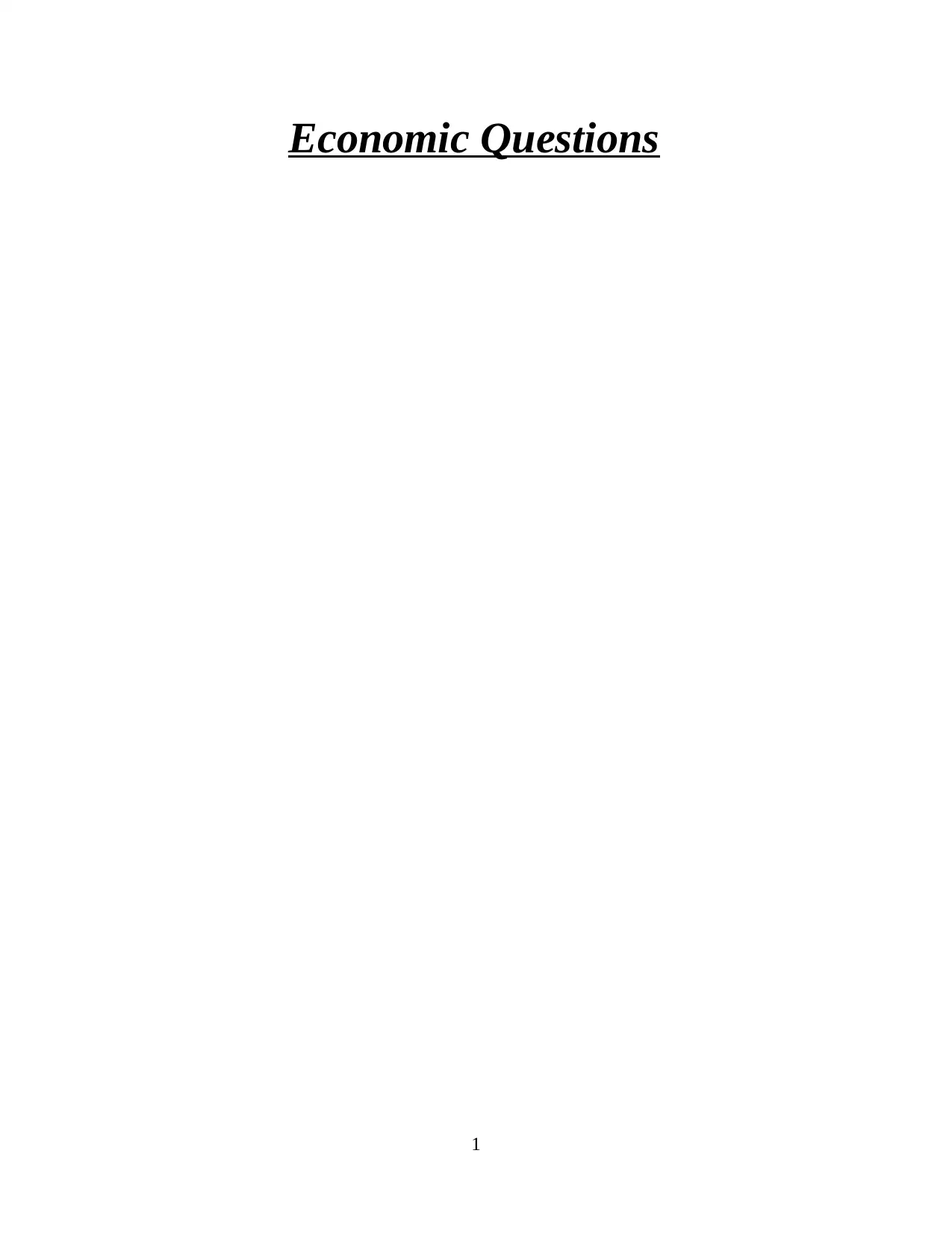
Economic Questions
1
1
Paraphrase This Document
Need a fresh take? Get an instant paraphrase of this document with our AI Paraphraser
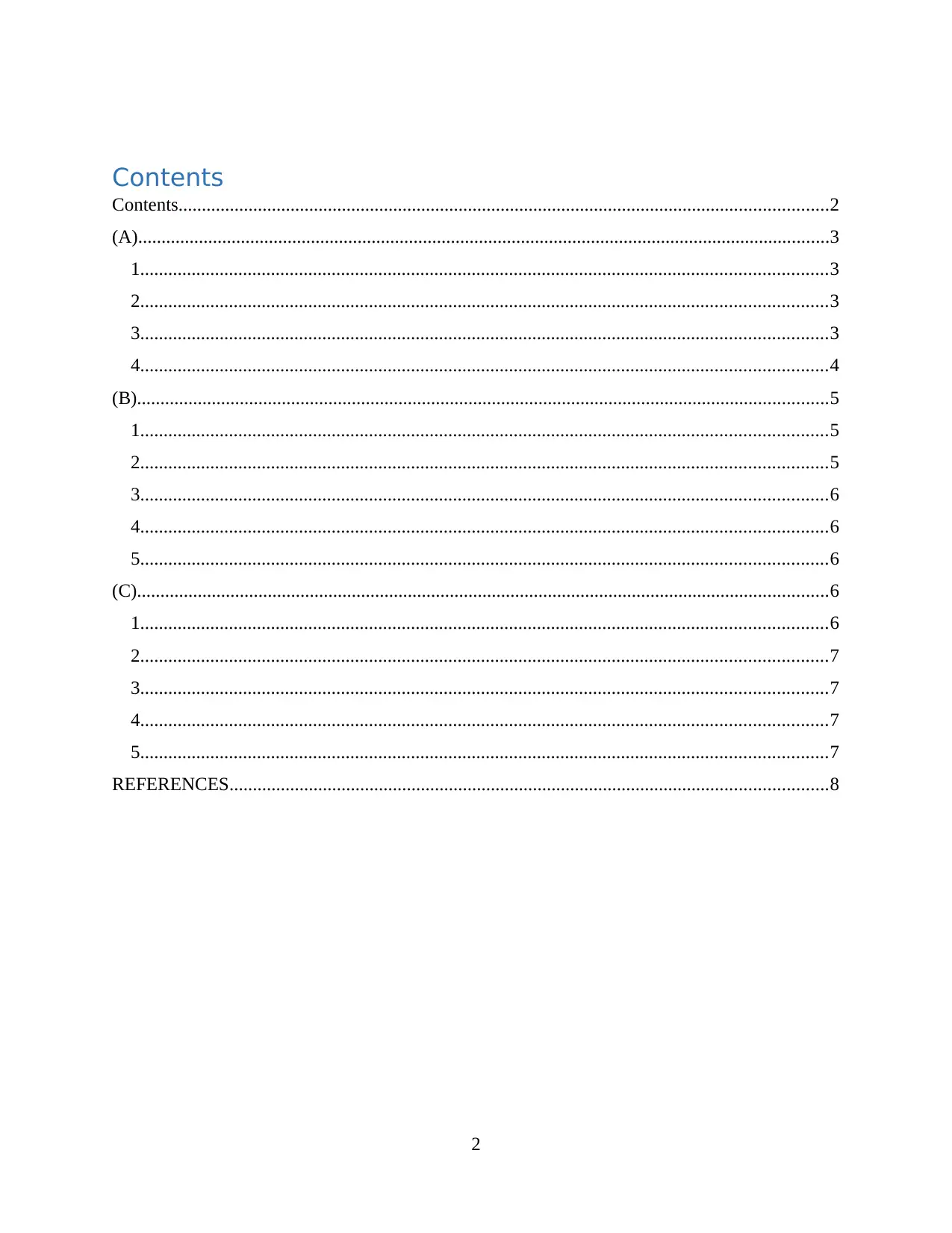
Contents
Contents...........................................................................................................................................2
(A)....................................................................................................................................................3
1...................................................................................................................................................3
2...................................................................................................................................................3
3...................................................................................................................................................3
4...................................................................................................................................................4
(B)....................................................................................................................................................5
1...................................................................................................................................................5
2...................................................................................................................................................5
3...................................................................................................................................................6
4...................................................................................................................................................6
5...................................................................................................................................................6
(C)....................................................................................................................................................6
1...................................................................................................................................................6
2...................................................................................................................................................7
3...................................................................................................................................................7
4...................................................................................................................................................7
5...................................................................................................................................................7
REFERENCES................................................................................................................................8
2
Contents...........................................................................................................................................2
(A)....................................................................................................................................................3
1...................................................................................................................................................3
2...................................................................................................................................................3
3...................................................................................................................................................3
4...................................................................................................................................................4
(B)....................................................................................................................................................5
1...................................................................................................................................................5
2...................................................................................................................................................5
3...................................................................................................................................................6
4...................................................................................................................................................6
5...................................................................................................................................................6
(C)....................................................................................................................................................6
1...................................................................................................................................................6
2...................................................................................................................................................7
3...................................................................................................................................................7
4...................................................................................................................................................7
5...................................................................................................................................................7
REFERENCES................................................................................................................................8
2
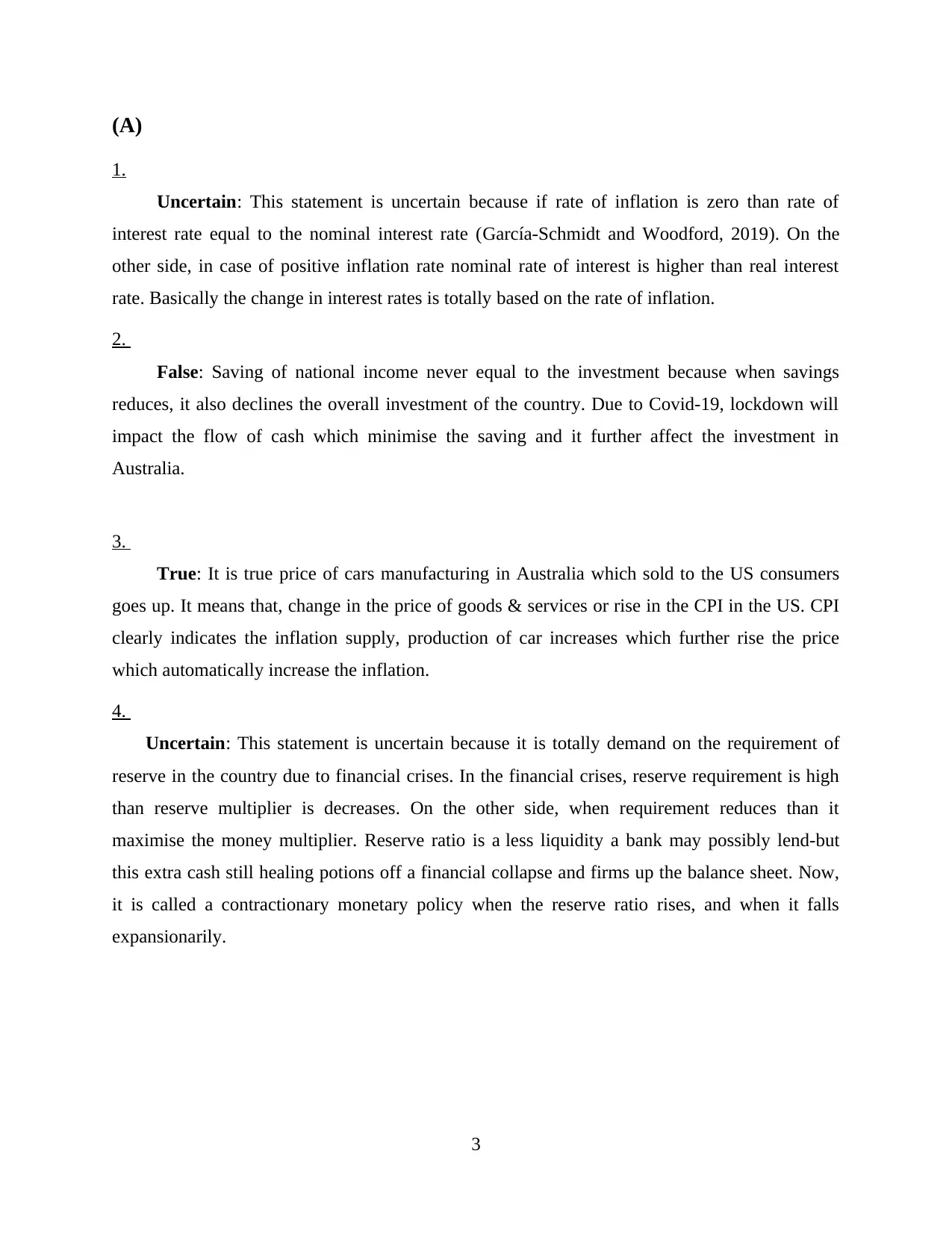
(A)
1.
Uncertain: This statement is uncertain because if rate of inflation is zero than rate of
interest rate equal to the nominal interest rate (García-Schmidt and Woodford, 2019). On the
other side, in case of positive inflation rate nominal rate of interest is higher than real interest
rate. Basically the change in interest rates is totally based on the rate of inflation.
2.
False: Saving of national income never equal to the investment because when savings
reduces, it also declines the overall investment of the country. Due to Covid-19, lockdown will
impact the flow of cash which minimise the saving and it further affect the investment in
Australia.
3.
True: It is true price of cars manufacturing in Australia which sold to the US consumers
goes up. It means that, change in the price of goods & services or rise in the CPI in the US. CPI
clearly indicates the inflation supply, production of car increases which further rise the price
which automatically increase the inflation.
4.
Uncertain: This statement is uncertain because it is totally demand on the requirement of
reserve in the country due to financial crises. In the financial crises, reserve requirement is high
than reserve multiplier is decreases. On the other side, when requirement reduces than it
maximise the money multiplier. Reserve ratio is a less liquidity a bank may possibly lend-but
this extra cash still healing potions off a financial collapse and firms up the balance sheet. Now,
it is called a contractionary monetary policy when the reserve ratio rises, and when it falls
expansionarily.
3
1.
Uncertain: This statement is uncertain because if rate of inflation is zero than rate of
interest rate equal to the nominal interest rate (García-Schmidt and Woodford, 2019). On the
other side, in case of positive inflation rate nominal rate of interest is higher than real interest
rate. Basically the change in interest rates is totally based on the rate of inflation.
2.
False: Saving of national income never equal to the investment because when savings
reduces, it also declines the overall investment of the country. Due to Covid-19, lockdown will
impact the flow of cash which minimise the saving and it further affect the investment in
Australia.
3.
True: It is true price of cars manufacturing in Australia which sold to the US consumers
goes up. It means that, change in the price of goods & services or rise in the CPI in the US. CPI
clearly indicates the inflation supply, production of car increases which further rise the price
which automatically increase the inflation.
4.
Uncertain: This statement is uncertain because it is totally demand on the requirement of
reserve in the country due to financial crises. In the financial crises, reserve requirement is high
than reserve multiplier is decreases. On the other side, when requirement reduces than it
maximise the money multiplier. Reserve ratio is a less liquidity a bank may possibly lend-but
this extra cash still healing potions off a financial collapse and firms up the balance sheet. Now,
it is called a contractionary monetary policy when the reserve ratio rises, and when it falls
expansionarily.
3
⊘ This is a preview!⊘
Do you want full access?
Subscribe today to unlock all pages.

Trusted by 1+ million students worldwide
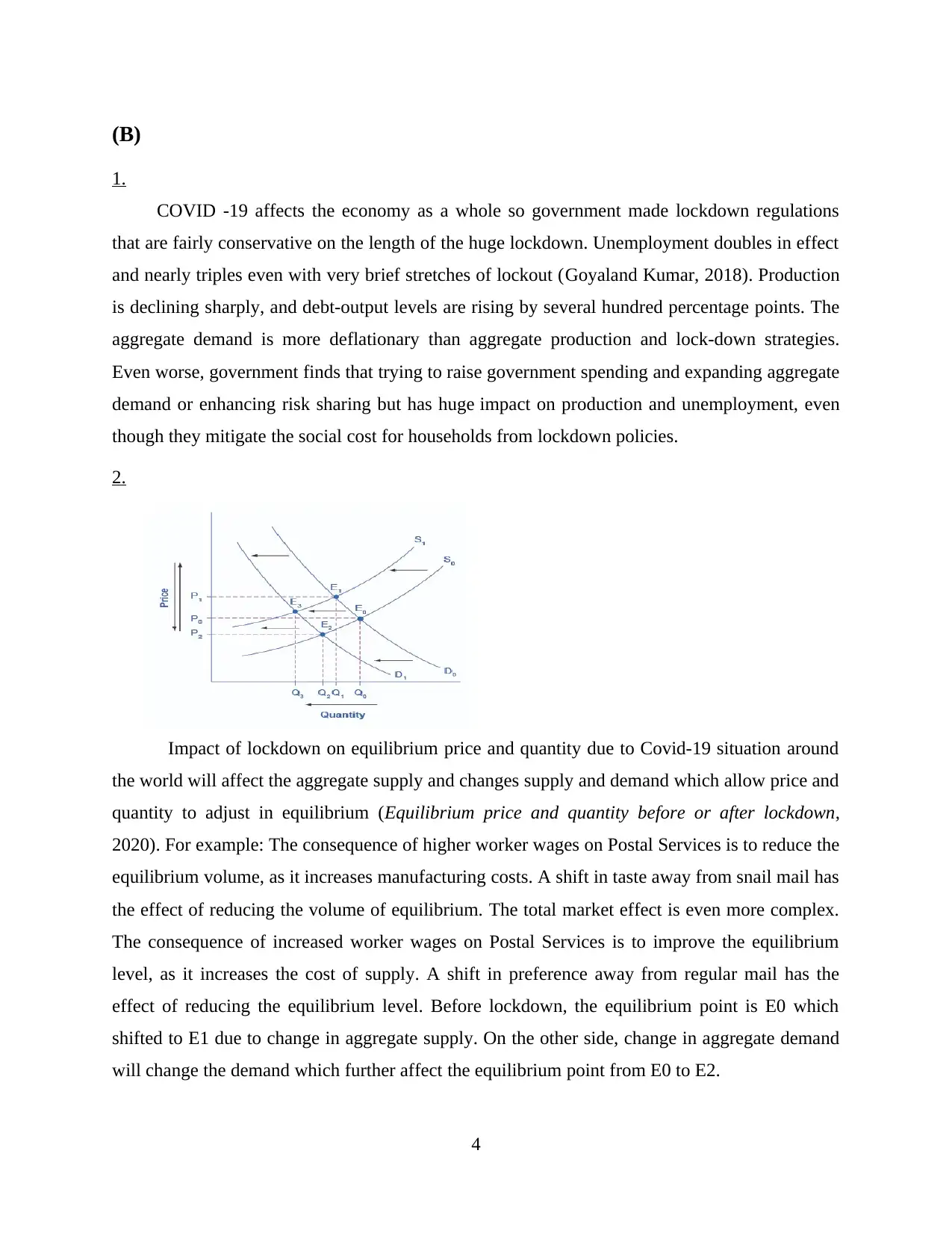
(B)
1.
COVID -19 affects the economy as a whole so government made lockdown regulations
that are fairly conservative on the length of the huge lockdown. Unemployment doubles in effect
and nearly triples even with very brief stretches of lockout (Goyaland Kumar, 2018). Production
is declining sharply, and debt-output levels are rising by several hundred percentage points. The
aggregate demand is more deflationary than aggregate production and lock-down strategies.
Even worse, government finds that trying to raise government spending and expanding aggregate
demand or enhancing risk sharing but has huge impact on production and unemployment, even
though they mitigate the social cost for households from lockdown policies.
2.
Impact of lockdown on equilibrium price and quantity due to Covid-19 situation around
the world will affect the aggregate supply and changes supply and demand which allow price and
quantity to adjust in equilibrium (Equilibrium price and quantity before or after lockdown,
2020). For example: The consequence of higher worker wages on Postal Services is to reduce the
equilibrium volume, as it increases manufacturing costs. A shift in taste away from snail mail has
the effect of reducing the volume of equilibrium. The total market effect is even more complex.
The consequence of increased worker wages on Postal Services is to improve the equilibrium
level, as it increases the cost of supply. A shift in preference away from regular mail has the
effect of reducing the equilibrium level. Before lockdown, the equilibrium point is E0 which
shifted to E1 due to change in aggregate supply. On the other side, change in aggregate demand
will change the demand which further affect the equilibrium point from E0 to E2.
4
1.
COVID -19 affects the economy as a whole so government made lockdown regulations
that are fairly conservative on the length of the huge lockdown. Unemployment doubles in effect
and nearly triples even with very brief stretches of lockout (Goyaland Kumar, 2018). Production
is declining sharply, and debt-output levels are rising by several hundred percentage points. The
aggregate demand is more deflationary than aggregate production and lock-down strategies.
Even worse, government finds that trying to raise government spending and expanding aggregate
demand or enhancing risk sharing but has huge impact on production and unemployment, even
though they mitigate the social cost for households from lockdown policies.
2.
Impact of lockdown on equilibrium price and quantity due to Covid-19 situation around
the world will affect the aggregate supply and changes supply and demand which allow price and
quantity to adjust in equilibrium (Equilibrium price and quantity before or after lockdown,
2020). For example: The consequence of higher worker wages on Postal Services is to reduce the
equilibrium volume, as it increases manufacturing costs. A shift in taste away from snail mail has
the effect of reducing the volume of equilibrium. The total market effect is even more complex.
The consequence of increased worker wages on Postal Services is to improve the equilibrium
level, as it increases the cost of supply. A shift in preference away from regular mail has the
effect of reducing the equilibrium level. Before lockdown, the equilibrium point is E0 which
shifted to E1 due to change in aggregate supply. On the other side, change in aggregate demand
will change the demand which further affect the equilibrium point from E0 to E2.
4
Paraphrase This Document
Need a fresh take? Get an instant paraphrase of this document with our AI Paraphraser
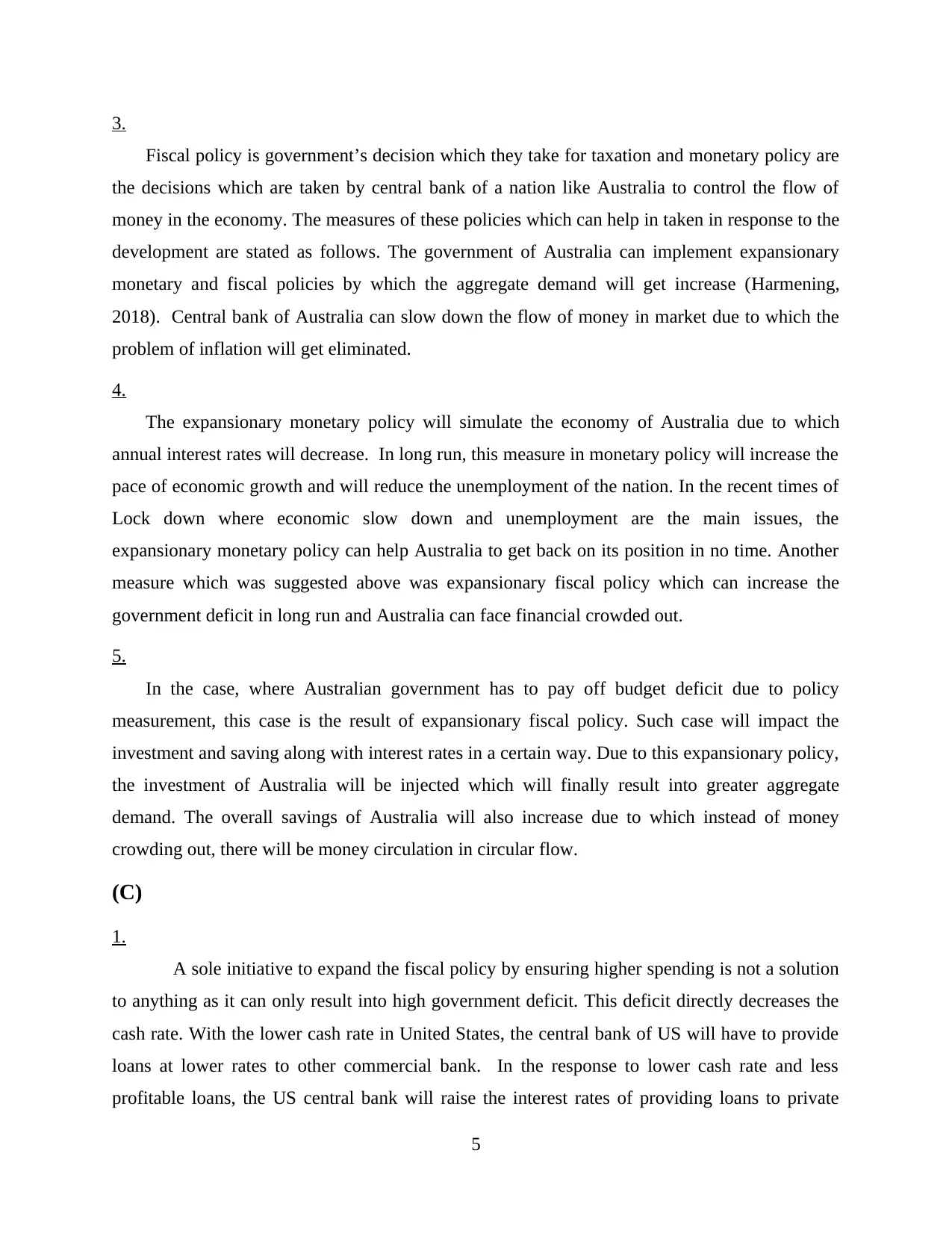
3.
Fiscal policy is government’s decision which they take for taxation and monetary policy are
the decisions which are taken by central bank of a nation like Australia to control the flow of
money in the economy. The measures of these policies which can help in taken in response to the
development are stated as follows. The government of Australia can implement expansionary
monetary and fiscal policies by which the aggregate demand will get increase (Harmening,
2018). Central bank of Australia can slow down the flow of money in market due to which the
problem of inflation will get eliminated.
4.
The expansionary monetary policy will simulate the economy of Australia due to which
annual interest rates will decrease. In long run, this measure in monetary policy will increase the
pace of economic growth and will reduce the unemployment of the nation. In the recent times of
Lock down where economic slow down and unemployment are the main issues, the
expansionary monetary policy can help Australia to get back on its position in no time. Another
measure which was suggested above was expansionary fiscal policy which can increase the
government deficit in long run and Australia can face financial crowded out.
5.
In the case, where Australian government has to pay off budget deficit due to policy
measurement, this case is the result of expansionary fiscal policy. Such case will impact the
investment and saving along with interest rates in a certain way. Due to this expansionary policy,
the investment of Australia will be injected which will finally result into greater aggregate
demand. The overall savings of Australia will also increase due to which instead of money
crowding out, there will be money circulation in circular flow.
(C)
1.
A sole initiative to expand the fiscal policy by ensuring higher spending is not a solution
to anything as it can only result into high government deficit. This deficit directly decreases the
cash rate. With the lower cash rate in United States, the central bank of US will have to provide
loans at lower rates to other commercial bank. In the response to lower cash rate and less
profitable loans, the US central bank will raise the interest rates of providing loans to private
5
Fiscal policy is government’s decision which they take for taxation and monetary policy are
the decisions which are taken by central bank of a nation like Australia to control the flow of
money in the economy. The measures of these policies which can help in taken in response to the
development are stated as follows. The government of Australia can implement expansionary
monetary and fiscal policies by which the aggregate demand will get increase (Harmening,
2018). Central bank of Australia can slow down the flow of money in market due to which the
problem of inflation will get eliminated.
4.
The expansionary monetary policy will simulate the economy of Australia due to which
annual interest rates will decrease. In long run, this measure in monetary policy will increase the
pace of economic growth and will reduce the unemployment of the nation. In the recent times of
Lock down where economic slow down and unemployment are the main issues, the
expansionary monetary policy can help Australia to get back on its position in no time. Another
measure which was suggested above was expansionary fiscal policy which can increase the
government deficit in long run and Australia can face financial crowded out.
5.
In the case, where Australian government has to pay off budget deficit due to policy
measurement, this case is the result of expansionary fiscal policy. Such case will impact the
investment and saving along with interest rates in a certain way. Due to this expansionary policy,
the investment of Australia will be injected which will finally result into greater aggregate
demand. The overall savings of Australia will also increase due to which instead of money
crowding out, there will be money circulation in circular flow.
(C)
1.
A sole initiative to expand the fiscal policy by ensuring higher spending is not a solution
to anything as it can only result into high government deficit. This deficit directly decreases the
cash rate. With the lower cash rate in United States, the central bank of US will have to provide
loans at lower rates to other commercial bank. In the response to lower cash rate and less
profitable loans, the US central bank will raise the interest rates of providing loans to private
5
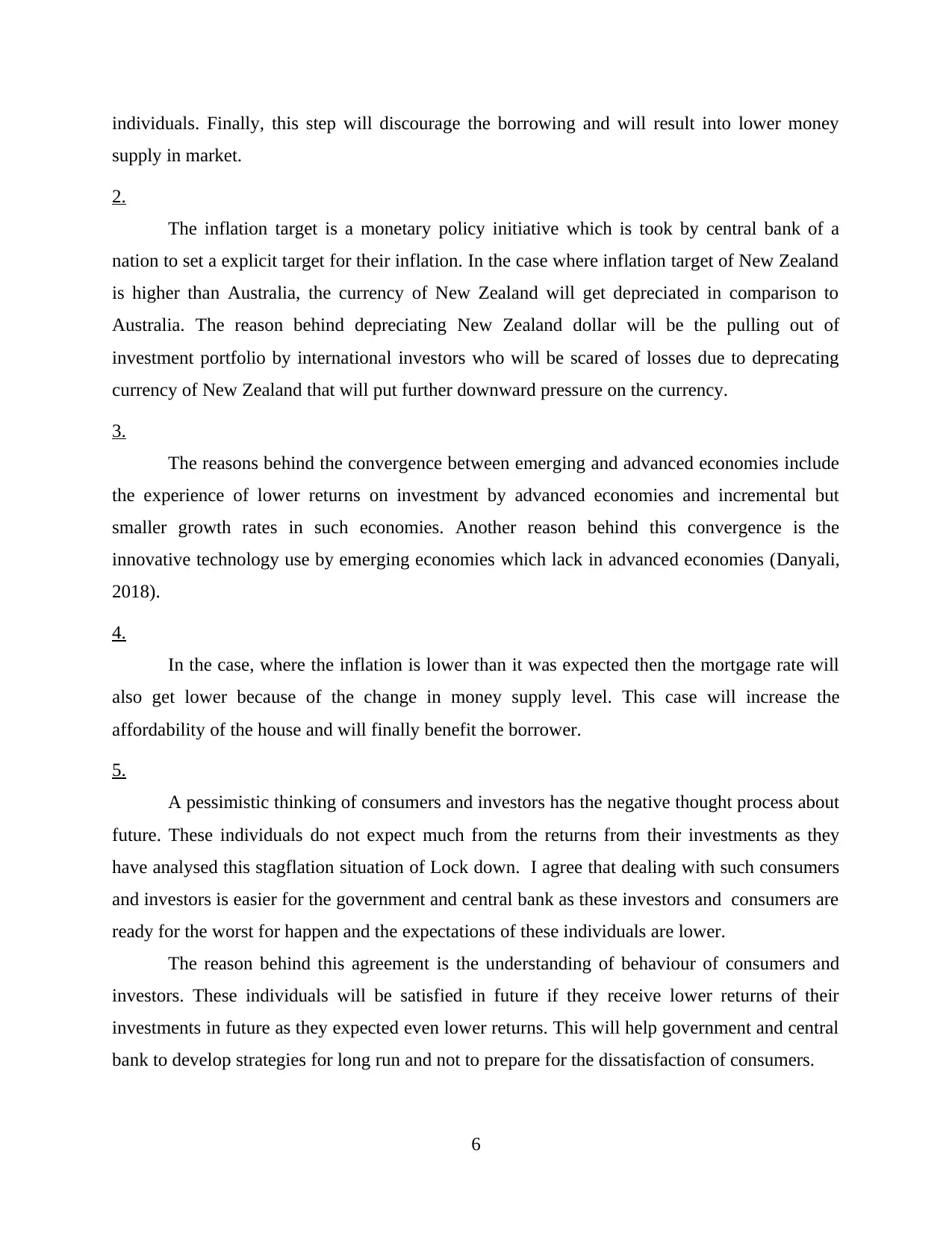
individuals. Finally, this step will discourage the borrowing and will result into lower money
supply in market.
2.
The inflation target is a monetary policy initiative which is took by central bank of a
nation to set a explicit target for their inflation. In the case where inflation target of New Zealand
is higher than Australia, the currency of New Zealand will get depreciated in comparison to
Australia. The reason behind depreciating New Zealand dollar will be the pulling out of
investment portfolio by international investors who will be scared of losses due to deprecating
currency of New Zealand that will put further downward pressure on the currency.
3.
The reasons behind the convergence between emerging and advanced economies include
the experience of lower returns on investment by advanced economies and incremental but
smaller growth rates in such economies. Another reason behind this convergence is the
innovative technology use by emerging economies which lack in advanced economies (Danyali,
2018).
4.
In the case, where the inflation is lower than it was expected then the mortgage rate will
also get lower because of the change in money supply level. This case will increase the
affordability of the house and will finally benefit the borrower.
5.
A pessimistic thinking of consumers and investors has the negative thought process about
future. These individuals do not expect much from the returns from their investments as they
have analysed this stagflation situation of Lock down. I agree that dealing with such consumers
and investors is easier for the government and central bank as these investors and consumers are
ready for the worst for happen and the expectations of these individuals are lower.
The reason behind this agreement is the understanding of behaviour of consumers and
investors. These individuals will be satisfied in future if they receive lower returns of their
investments in future as they expected even lower returns. This will help government and central
bank to develop strategies for long run and not to prepare for the dissatisfaction of consumers.
6
supply in market.
2.
The inflation target is a monetary policy initiative which is took by central bank of a
nation to set a explicit target for their inflation. In the case where inflation target of New Zealand
is higher than Australia, the currency of New Zealand will get depreciated in comparison to
Australia. The reason behind depreciating New Zealand dollar will be the pulling out of
investment portfolio by international investors who will be scared of losses due to deprecating
currency of New Zealand that will put further downward pressure on the currency.
3.
The reasons behind the convergence between emerging and advanced economies include
the experience of lower returns on investment by advanced economies and incremental but
smaller growth rates in such economies. Another reason behind this convergence is the
innovative technology use by emerging economies which lack in advanced economies (Danyali,
2018).
4.
In the case, where the inflation is lower than it was expected then the mortgage rate will
also get lower because of the change in money supply level. This case will increase the
affordability of the house and will finally benefit the borrower.
5.
A pessimistic thinking of consumers and investors has the negative thought process about
future. These individuals do not expect much from the returns from their investments as they
have analysed this stagflation situation of Lock down. I agree that dealing with such consumers
and investors is easier for the government and central bank as these investors and consumers are
ready for the worst for happen and the expectations of these individuals are lower.
The reason behind this agreement is the understanding of behaviour of consumers and
investors. These individuals will be satisfied in future if they receive lower returns of their
investments in future as they expected even lower returns. This will help government and central
bank to develop strategies for long run and not to prepare for the dissatisfaction of consumers.
6
⊘ This is a preview!⊘
Do you want full access?
Subscribe today to unlock all pages.

Trusted by 1+ million students worldwide
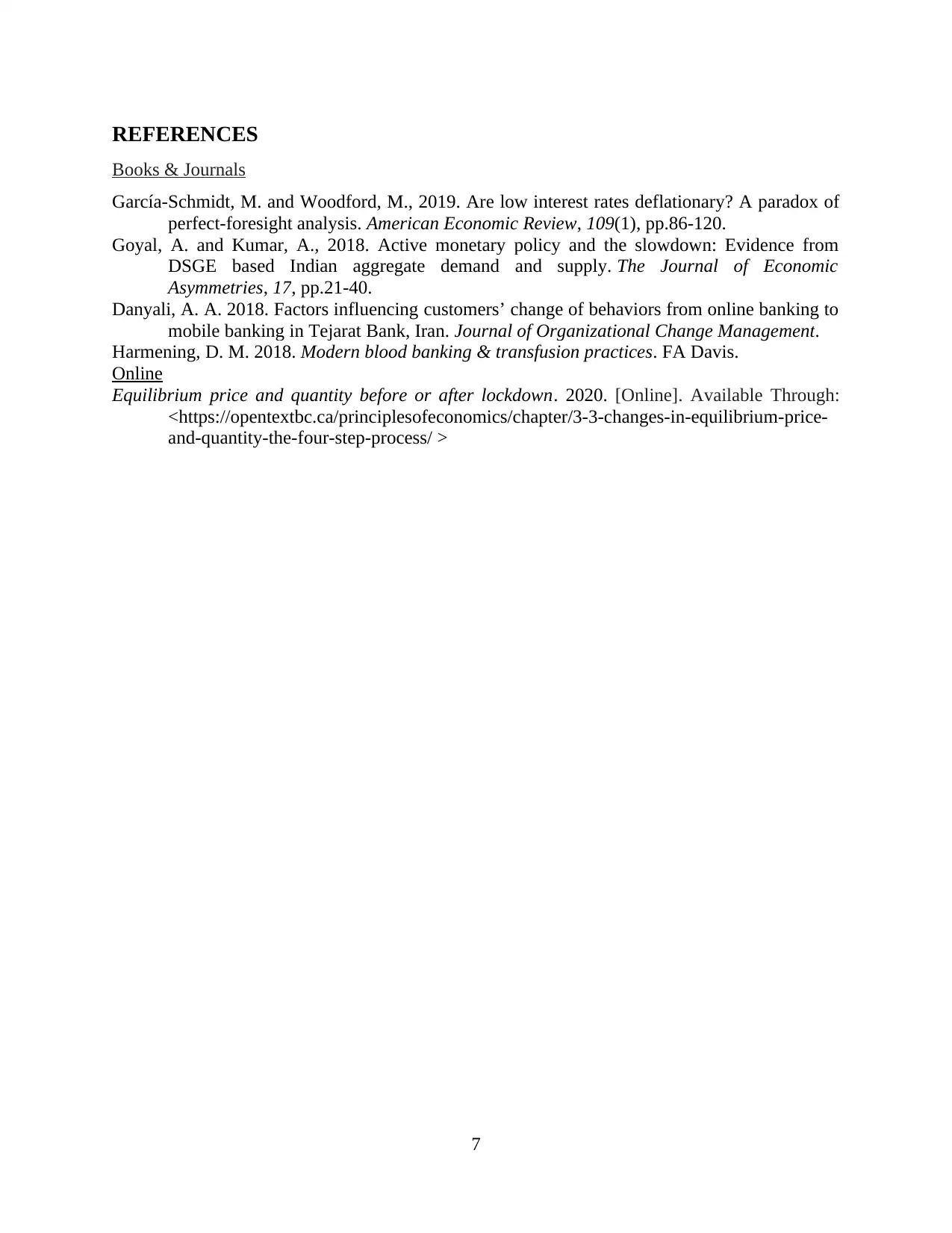
REFERENCES
Books & Journals
García-Schmidt, M. and Woodford, M., 2019. Are low interest rates deflationary? A paradox of
perfect-foresight analysis. American Economic Review, 109(1), pp.86-120.
Goyal, A. and Kumar, A., 2018. Active monetary policy and the slowdown: Evidence from
DSGE based Indian aggregate demand and supply. The Journal of Economic
Asymmetries, 17, pp.21-40.
Danyali, A. A. 2018. Factors influencing customers’ change of behaviors from online banking to
mobile banking in Tejarat Bank, Iran. Journal of Organizational Change Management.
Harmening, D. M. 2018. Modern blood banking & transfusion practices. FA Davis.
Online
Equilibrium price and quantity before or after lockdown. 2020. [Online]. Available Through:
<https://opentextbc.ca/principlesofeconomics/chapter/3-3-changes-in-equilibrium-price-
and-quantity-the-four-step-process/ >
7
Books & Journals
García-Schmidt, M. and Woodford, M., 2019. Are low interest rates deflationary? A paradox of
perfect-foresight analysis. American Economic Review, 109(1), pp.86-120.
Goyal, A. and Kumar, A., 2018. Active monetary policy and the slowdown: Evidence from
DSGE based Indian aggregate demand and supply. The Journal of Economic
Asymmetries, 17, pp.21-40.
Danyali, A. A. 2018. Factors influencing customers’ change of behaviors from online banking to
mobile banking in Tejarat Bank, Iran. Journal of Organizational Change Management.
Harmening, D. M. 2018. Modern blood banking & transfusion practices. FA Davis.
Online
Equilibrium price and quantity before or after lockdown. 2020. [Online]. Available Through:
<https://opentextbc.ca/principlesofeconomics/chapter/3-3-changes-in-equilibrium-price-
and-quantity-the-four-step-process/ >
7
1 out of 7
Related Documents
Your All-in-One AI-Powered Toolkit for Academic Success.
+13062052269
info@desklib.com
Available 24*7 on WhatsApp / Email
![[object Object]](/_next/static/media/star-bottom.7253800d.svg)
Unlock your academic potential
Copyright © 2020–2025 A2Z Services. All Rights Reserved. Developed and managed by ZUCOL.




